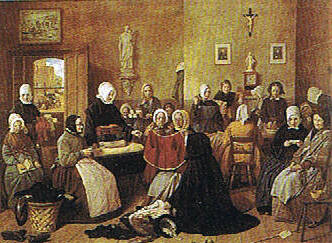
By: James Collison
 Discovered by chance in 1973 at an antique dealer’s in Carlisle, England, this painting was transported shortly afterwards to La Tour St. Joseph and hung in the Motherhouse parlor.
Discovered by chance in 1973 at an antique dealer’s in Carlisle, England, this painting was transported shortly afterwards to La Tour St. Joseph and hung in the Motherhouse parlor.
This canvas, which is 3 feet by 3 feet 8 inches, is due to James Collinson (1825-1881), an English painter belonging to the school of the Pre-Raphaelites, which appeared in England, in 1848 and is characterized by attention to detail and perfection in realization. Collinson pushed veracity so far as to write on the envelope fallen on the floor (on the right), the name and address of the elderly blind lady, Mary Hayes.
The register of the first foundation in London notes that Mary Hayes was admitted on January 15, 1968 and died there on October 9, 1869. This detail has made it possible to situate the work of James Collinson between 1868 and 1869, for according to specialists, about two years is needed to paint such a large canvas.
Another convincing detail is the building that can be seen through the window. It is perfectly identifiable as the Home of the Little Sisters on Portobello Road, founded in 1851, that they had to leave in 1978.
This hospitality scene is remarkable for its trueness to life and for its exactness of observation. The Little Sisters are very young, for the Congregation did not yet have 30 years of existence! It is almost certain that the Little Sister reading the letter to Mary Hayes is Sr. Emmanuel, the only one capable of reading English properly at that time.
Another painting exists, or existed-for no trace of it has ever been found, despite many investigations which are going nevertheless to continue-representing the Little Sisters serving the men on a feast day. Here in La Tour we have a photograph of both paintings, bearing this inscription: “Painted and photographed by James Collinson.” A letter of Pere Lelievre, written from La Tour on June 15, 1875 to his friend in Amiens, Louis Marest, gives very interesting details about this painting, and enables us to know that it was painted before that of the elderly women, in 1866-1867.
Here is the text of the letter:
“My very dear friend,
if am not mistaken, you have in your dining room two photographs of two scenes showing the dining rooms of the men and women of our home at Portobello, and people whom we would have met there nine years ago. In the first of these two dining rooms look for a gentleman who is standing and cutting a loaf of bread. He is rather tall, has a high forehead and a very modest demeanor, eyes cast down, not wearing a suit, but with his vest and suspenders visible. This gentleman is called Richard, whom the Sisters call Richotte due to their poor understanding of the English accent. Mother Saint Louis and Mother Pauline welcomed him into the home at Sutherland Gardens during the days of its foundation and if he was not the first of the elderly men received, he was the second. As soon as the infirmary area of the home began to welcome the sick, which occurred right after the home was opened, he asked for and obtained the office of assistant to the Little Sister infirmarian. It is an employment that he fulfilled up until last May, and this with as much exactitude, zeal, and patience as would the most devoted of the Sisters. He desired the most repulsive tasks. He slept in the midst of the sick and was at their service day and night; he was always happy and had a pleasant countenance; he never took a day off,’ never had free time or other occupations than that of cleaning the rooms or hallways, or praying to God in the chapel. He received Holy Communion with the Sisters, and went to confession each week.
In all the time that I knew him, I do not think that he lost for more than a quarter of an hour the presence of God. He has just died. He received, during his last moments, the greatest honour that could be paid to the first Lord of England. The Cardinal Archbishop was visiting the home just then. He approached the bed of our good man, knelt down, recited the prayers for the dying, and gave him the final blessing. This coincidence is very extraordinary. Here is what I think: God willed to grant this distinguished glory to his dying servant as a prelude and a certain pledge of that which He was preparing for him above. I am sure, and I say this weighing my words, that after having sent his earthly angel to the bedside of this poor man, He deputized those of heaven to introduce this soul into the eternal tabernacles … See what the fourteen years of this service of charity to the dying were … 0 Richard, if there is a man on this earth whom I envied, and of whom I am still a little jealous, it is you! In whom have I seen, as in him, faith and hope united in charity? His countenance and his gaze said everything: his life also said everything! f forgot to mention that when he entered the home, he was stone-deaf. He supported this infirmity with the same even temper as he did everything else. They say that his last moments were those of a saint: I well believe it. Now all that I can say is this: ‘Richard, remember that I was your friend, and even though you were poor, I never treated you without respect!”
Ernest Lelievre




HOSPITALITY SCENE IN LONDON